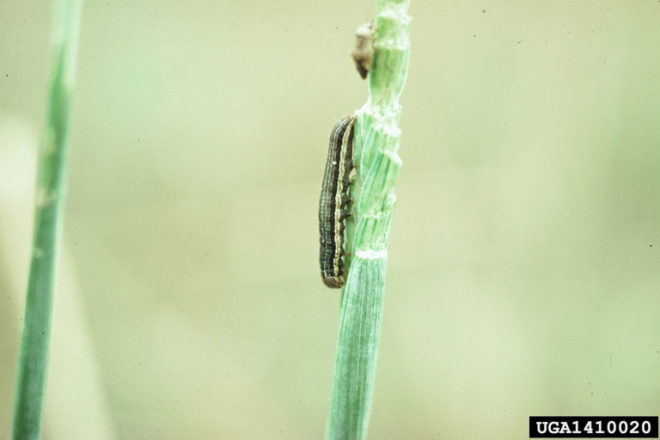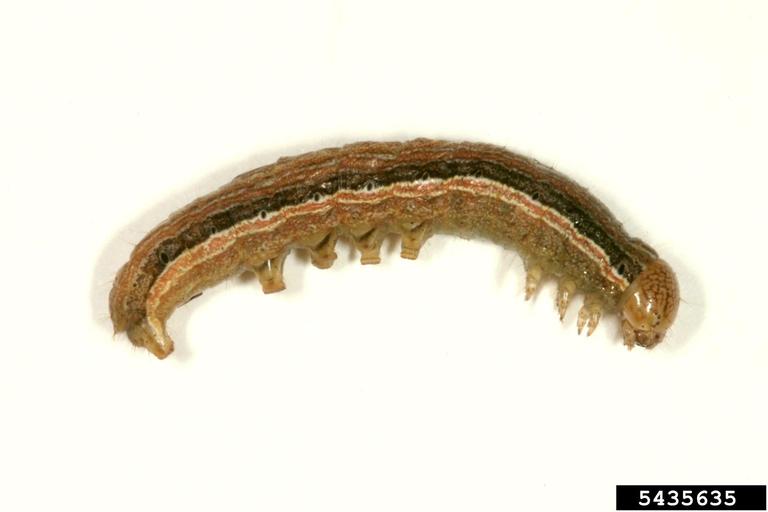The March of the Armyworms
- Share
- Tweet
- Pin
- Share

True armyworms, Pseudaletia unipuncta Haworth (Lepidoptera: Noctuidae), are on the march this year. This moth species gets its name from the behavior of the caterpillars, which will completely consume one food source and then walk, en masse, to the next area to continue eating. We haven’t seen major armyworm infestations for a while, but this year in certain areas they are definitely active.
True armyworms should not be confused with other species such as tent caterpillars, gypsy moth, sawflies, cutworms and the fall armyworm. True armyworms do not build webbed nests and they typically don’t defoliate trees unless all other food sources are gone.
Armyworm caterpillars are smooth-skinned with several dark brown, white or orange-ish stripes down the length of their body. Their overall body color can range from yellowish-green to dark gray or brown. The true armyworm’s head capsule is brown with a series of web-like markings, making it look like it has large, veiny eyes. Mature larvae are around 1½ inches long.
Adult armyworm moths are tan to light brown and have a small white spot in the center of each forewing. They are one inch long with a 1½-inch wingspan. Armyworms pupate just below the soil surface. Around here, there are typically two to three generations per year.
Armyworms are not a problem in Wisconsin every year because they don’t spend the winter here. Like many of our snowbirds, armyworm moths overwinter in the southern United States and migrate up here in storm systems throughout the spring. For whatever reason, this year they “decided” that northern Wisconsin would be a great place to visit! This means that while we might have high numbers of armyworms this year, there is no indication that we will have large populations of them next year.

Armyworm larva. Photo by James Kalisch, University of Nebraska, Bugwood.org
After the adults arrive in the north, they mate and females lay eggs, primarily at the base of grasses and other plants. In agricultural fields, the moths preferentially lay eggs in reduced tillage fields with crop residue, weedy areas or grassy strips near fields. As armyworm caterpillars grow, they feed on grasses, including pastures, small grains, corn and turf. As one food source is consumed, they move on to the next. If an herbicide is used to control grasses or a crop is harvested, the armyworms will also move to nearby sites.
In small grain fields, armyworm larvae chew holes in the plant leaves and can completely strip plants as they move up the stalk. At the top, they feed on kernels and clip the stem just below the head. The treatment threshold in small grains is three larvae per square foot. Because the caterpillars primarily feed at night, check on the soil surface and under plant residue when searching for them. If using an insecticide, be aware of the pre-harvest interval of the product before use.
In corn fields, armyworm feeding damage results in large chunks taken out of the leaves and often the whorl is full of insect frass (poop). If there are signs of armyworm feeding, check five sets of 20 plants at random throughout the field. Rather than looking at how much damage has already been done, focus treatments on preventing additional damage. The treatment threshold is if 75 percent of plants have one caterpillar or 25 percent of the plants have two caterpillars inside. Also, keep in mind that caterpillars that are longer than one inch long are almost done feeding, so using an insecticide may not be necessary. Unfortunately, many fields have larvae that are at a range of sizes. Spot treatments are ideal, but that option depends on the results of scouting. Corn with above ground Bt trait(s) may still be attacked, so check those as well.
Pastures, soybeans, alfalfa, and other crops are not immune to damage either, especially with large armyworm populations. Insecticide recommendations for commercial field crops can be found in the UW publication A3646, Pest Management in Wisconsin Field Crops.
In a lawn, before treating, check the ground and throughout the turf thatch at the lawn edge to see if larvae are present. This is especially important if the lawn borders a grassy area or recently harvested agricultural field. If larvae are found and are only on the edge, spot treating in that area using an insecticide labeled for turf that targets caterpillars should be effective. This may need to be repeated as the “army” continues to march forward.
If larvae are already throughout the lawn, the entire yard may need to be treated. Both liquid and granular products are available. If the caterpillars are longer than one inch, they are almost done feeding and it is best to let them finish eating and focus on restoring the turf.
Backyard corn plots are also susceptible to damage. If there is leaf notching and you are seeing frass in the whorl, search around the base of the plants or in grassy weeds for caterpillars and squish as many as possible (dropping them into a bucket of soapy water is also an extermination method if squishing isn’t your thing). Larvae in a corn plant can also be carefully extracted and squished. Insecticides labeled for use in corn can be used if necessary, but again, be aware of the pre-harvest interval for any insecticide and follow all label requirements since the label is the law.
Hopefully the armyworms we are seeing now are the end of the second generation and will be the last we see of them for a while. And maybe next year we can convince these moth snowbirds to spend the summer elsewhere.
For more information about controlling armyworms, contact the Door County UW-Extension office at 920.746.2260 or [email protected].

